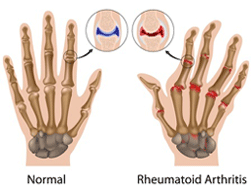 Rheumatoid
arthritis (RA) is a chronic progressive systemic inflammatory
disease that affects joints at the wrist, knee, cervical spine and
joints of the fingers, hands or knees (1, 2, 3, 4, 5, 6). It can
also affect organs such as the eyes, heart or lungs (1, 2). RA
affects 1.3 million U.S. adults (1). It is more common among women
than men by a ratio of 5:1 and often begins between the fourth and
sixth decades of life (1, 3). RA is a highly disabling disease
associated with morbidity (3). Yelin et al (4), reported that
despite receiving appropriate drug therapy, up to 7% of patients are
disabled to some extent 5 years after the onset of RA and 50% are
too disabled to work 10 years after onset.
Rheumatoid
arthritis (RA) is a chronic progressive systemic inflammatory
disease that affects joints at the wrist, knee, cervical spine and
joints of the fingers, hands or knees (1, 2, 3, 4, 5, 6). It can
also affect organs such as the eyes, heart or lungs (1, 2). RA
affects 1.3 million U.S. adults (1). It is more common among women
than men by a ratio of 5:1 and often begins between the fourth and
sixth decades of life (1, 3). RA is a highly disabling disease
associated with morbidity (3). Yelin et al (4), reported that
despite receiving appropriate drug therapy, up to 7% of patients are
disabled to some extent 5 years after the onset of RA and 50% are
too disabled to work 10 years after onset.
Signs and Symptoms of Rheumatoid Arthritis
Symptoms of RA usually present insidiously and progress slowly (2).
Individuals with RA usually complain of experiencing prolonged
stiffness in the morning, joint pain, fatigue, weakness,
psychological depression, swelling, palmar erythema, cool moist
skin, muscular atrophy, contracture of joints, weight loss, synovial
hernias, increased temperature, and the development of firm lumps,
called rheumatoid nodules, which grow beneath the skin in places
such as the elbow, Achilles tendon and hands (1, 3, 5).
Etiology / Diagnosis
The cause of RA is unknown. However, it is believed that an
autoimmune response plays an important role (1, 2). Approximately
80% of individuals with RA are rheumatoid factor-positive (2).
Rheumatoid factors are antibodies that react with immunoglobulin
antibodies found in the blood, synovial fluid and synovial membrane
(2). It is believed that the interaction between the rheumatoid
factor and immunoglobulin results in an inflammatory reaction (2).
From this reaction destructive lysomal enzymes are released which
contribute to articular destruction and synovial hyperplasia (2).
A rheumatologist is able to determine a diagnosis of RA based on
history, physical exam and various blood tests (1, 2). Table 1 lists
the diagnostic criteria proposed by the American Rheumatism
Association (7).
Table 1 - American Rheumatism Association Diagnostic Criteria for RA
RA criteria: (if 5 out of following are present for > 6 weeks);
• morning stiffness
• pain on motion, or tenderness in at least one joint
• swelling (soft tissue thickening or fluid, not bony overgrowth
alone) in at least one joint
• swelling of at least one other joint (any interval free of joint
symptoms between the two joint)
• poor mucin precipitate from synovial fluid
• characteristic histologic changes in synovium
• characteristic histologic changes in nodules
Physical Therapy and Rheumatoid Arthritis
The treatment goals for a patient with RA are to reduce pain,
maintain mobility, minimize stiffness, control edema & inflammation
and minimize joint destruction (2). Physical therapy intervention
can help with preventing contractures, improving strength &
flexibility and promoting aerobic conditioning (2).
A Cochrane Review by Ottawa panel members (3) found good evidence
that therapeutic exercises, including functional strengthening and
low- or high-intensity exercises, relieve pain and improve overall
function in patients with RA. It also recommended further research
to determine the efficacy of manual therapy in the management of RA.
A study by Swardh et al. (6) found that when working with patients
with RA, it is important to find the proper context and support for
each patient’s needs. Furthermore, preparing for exercise
maintenance by strengthening the patient’s beliefs in his or her
ability to exercise in different settings, by discussing pros and
cons of exercise, and by exploiting the patient’s ability to adapt
and continue exercise outside of the health care environment might
be valuable (6).
Last revised: April 21, 2014
by Amber Devine, PA-C & Chai Rasavong, MPT, MBA
References
1)
https://www.rheumatology.org last accessed 4/20/14
2) Goodman, C & Boissonnault W. Pathology: Implications for
the Physical Therapist. Philadelphia, PA: WB Saunders, 1998.
3) Brosseau L et al. Ottawa Panel Evidence-Based Clinical
Practice Guidelines for Therapeutic Exercises in the
Management of Rheumatoid Arthritis in Adults. Physical
Therapy. 2004;84:934-972.
4) Yellin E et al. Work Disability in Rheumatoid Arthritis:
Effects of Disease, Social & Work Factors. Ann Intern Med.
1980;93:551-556.
5) Breedland et al. Effects of Group-Based Exercise and
Educational Program on Physical Performance and Disease
Self-Management in Rheumatoid Arthritis: A Randomized
Controlled Study. Physical Therapy. 2011; 91:879-893
6) Swardh E et al. Views on Exercise Maintenance: Among Patients with Rheumatoid Arthritis. Physical Therapy.
2008; 88:1049-1060.
7)
http://www.wheelessonline.com last accessed 4/20/14


 Rheumatoid
arthritis (RA) is a chronic progressive systemic inflammatory
disease that affects joints at the wrist, knee, cervical spine and
joints of the fingers, hands or knees (1, 2, 3, 4, 5, 6). It can
also affect organs such as the eyes, heart or lungs (1, 2). RA
affects 1.3 million U.S. adults (1). It is more common among women
than men by a ratio of 5:1 and often begins between the fourth and
sixth decades of life (1, 3). RA is a highly disabling disease
associated with morbidity (3). Yelin et al (4), reported that
despite receiving appropriate drug therapy, up to 7% of patients are
disabled to some extent 5 years after the onset of RA and 50% are
too disabled to work 10 years after onset.
Rheumatoid
arthritis (RA) is a chronic progressive systemic inflammatory
disease that affects joints at the wrist, knee, cervical spine and
joints of the fingers, hands or knees (1, 2, 3, 4, 5, 6). It can
also affect organs such as the eyes, heart or lungs (1, 2). RA
affects 1.3 million U.S. adults (1). It is more common among women
than men by a ratio of 5:1 and often begins between the fourth and
sixth decades of life (1, 3). RA is a highly disabling disease
associated with morbidity (3). Yelin et al (4), reported that
despite receiving appropriate drug therapy, up to 7% of patients are
disabled to some extent 5 years after the onset of RA and 50% are
too disabled to work 10 years after onset. 



